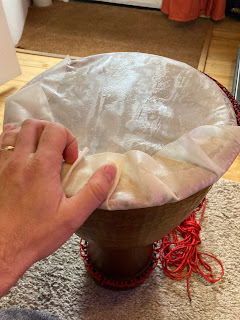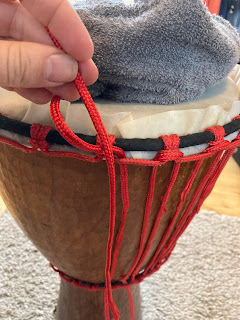Restoring a Djembe
Aims – Start a Djembe community drumming group
Objectives – Having acquired a Djembe with a split head, I went about learning how to replace it.
Plan/timescale
Week 1 – Research, evidence in Blog
Week 2 – Develop plan in line with discovery from research, Initial Demos, 3 ideas
Week 3 – Develop and measure against objectives, find a new source to help me improve them.
Week 4 – Skill development with Evidence
Week 5 – Completion of modified objectives
Week 6 – reflection, evaluation and plan for next steps development
 I discovered that Female Goat Vellum is better as it does not smell as much! You need a lot of extra size for the overlaps at the edges. You align the spine across the middle of the drum as it is thickest with the shoulders nearest you as a player (use the knot on the ropes to identify the playing position). The Vellum has the smooth side out and the veiny side inside.
I discovered that Female Goat Vellum is better as it does not smell as much! You need a lot of extra size for the overlaps at the edges. You align the spine across the middle of the drum as it is thickest with the shoulders nearest you as a player (use the knot on the ropes to identify the playing position). The Vellum has the smooth side out and the veiny side inside. Smooth with fine sandpaper lightly and prepare the wood - especially with attention to the playing edges.
Smooth with fine sandpaper lightly and prepare the wood - especially with attention to the playing edges. The metal hoop - which I covered and glued (fabric glue at start and end) with spare cotton strips, is placed over the head and the head flipped up to make a 'pie crust'.
The metal hoop - which I covered and glued (fabric glue at start and end) with spare cotton strips, is placed over the head and the head flipped up to make a 'pie crust'. Using a damp towel to hold it in place, I then started to loosely restring the ropes to hold it in place.
Using a damp towel to hold it in place, I then started to loosely restring the ropes to hold it in place. A soft rubber mallet ensures the ring is seated and moving properly - a light tap on the rope knots all the way around.
A soft rubber mallet ensures the ring is seated and moving properly - a light tap on the rope knots all the way around. After drying overnight, locking pliers help to get the slack out and being tuning, using the drum stick to add tension to the ropes.
After drying overnight, locking pliers help to get the slack out and being tuning, using the drum stick to add tension to the ropes. The end of the rope is knotted off and the excess used to go around and under each pair of ropes to lock and tighten them horizontally. At this point, low patches can be brought into tune with extra horizontal passes of the rope.
The end of the rope is knotted off and the excess used to go around and under each pair of ropes to lock and tighten them horizontally. At this point, low patches can be brought into tune with extra horizontal passes of the rope. Evaluating this drum, the head is nice and pingy but I used a very light vellum that sounds more like a Darabuka. Next time, I will use a thinker skin with the fur on. I will shave and lightly sand it as the last step. This should give a more traditional West African sound.
Evaluating this drum, the head is nice and pingy but I used a very light vellum that sounds more like a Darabuka. Next time, I will use a thinker skin with the fur on. I will shave and lightly sand it as the last step. This should give a more traditional West African sound.This video gives us an idea about the work that goes into a traditional Djembe.
You get a really good view of how to 'lock' the ropes when running around with the first tuning pass in this video.












Comments
Post a Comment